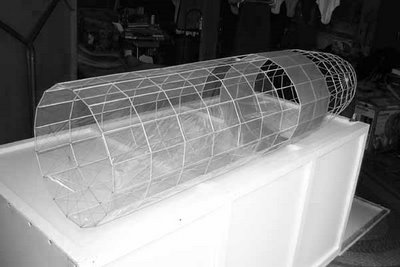Unmediating the Media

I enjoy viewing well-made photographs on certain websites. For instance, the Toy Camera Forum often displays galleries of images that appeal to me for their square format, black & white image tone, softness and light falloff in the corners - the classic 'Diana' or 'Holga' look. Even though most of the cameras being used have plastic lenses, and are considered 'disposable' or 'junk' by the standards of the photo-professionals.
Similarly, I gain tremendous enjoyment from viewing and participating in an exchange of images and ideas on the pinhole photography forum at f295.
Interestingly, at the same time, I don't get much out of ultra-sharp, moody, slickly produced landscape images. I think it's not as much the image itself that bothers me, but what the 'production values' implicit to the image speak to me: cliché. Cliché in the drama presented by the landscape. Cliché in the split filtering of the sky in certain color landscapes. Cliché in the darkened, dramatic sky in certain black & white landscapes. Cliché in the ultra-saturated colors of the floral or lushly vegetative landscape.
It becomes as meaningless as watching too many action movies. Ho-hum, just another car chase or shoot-'em-up scene. Images such as those mentioned seem to be engaged in an overt, poorly disguised form of crudely emotional manipulation, of the kind one becomes all too familiar with from watching commercial television, or any other highly mediated format.
Mediation: that seems to be the key to understanding my feelings. It's a term one doesn't regularly happen upon, outside of the milieu of university media studies. The concept of mediation presupposes that all physical forms of communication impart their own coloration and filtering to whatever is being transmitted. Implying that the communication channel itself guarantees that there can be no unbiased facts presented. The mere presence of information being conveyed via newspaper, magazine, TV, radio or website is proof positive that bias is present.
The truly unbiased communication channel contains only dead air. Randomness. Once any information is added, it is immediately distorted by the very mechanism that conveys the information: it has become mediated.
In our search for truth it is imperative that we understand and harness the power of mediation, if we are to effectively communicate at all.
It therefore becomes necessary to explore the "noise floor", to borrow a term from the television field. For if randomness equates to a truly unbiased communication channel, then increasing the noise level becomes, counter-intuitively, the only true path to freeing up a medium from the debilitating effects of mediation.
And therein lies the secret behind the enormous, global push to advance hi-definition television: rather then freeing us from the distortions of the older media's 'artifacts', the promises of the new media only disguise its intrinsic capability to control, manipulate and distort, through the falsehood of its supposed ultra-clarity.
Beware what is hidden behind the spectacle of clarity: the truly invisible.
Photographs are proxy-holders. They possess an Orwellian Newthink duality whereby the viewer simultaneously holds two diametrically opposing views to be equally true: that, on the one hand, the photograph possesses the power to be equated with the subject represented; and second, that the photograph is a mere representation, an abstraction, of a disparate subject matter.
This duality defines the chasm between what we now know as art versus craft. Art suspends disbelief long enough for us to know that the picture of a mountain is, in fact, a mountain; craft suspends the suspension of disbelief for us to know that this is, in fact, a picture of a mountain, and not the mountain itself. The focus of craft upon the materials and techniques at hand helps to break the spell of Orwellian Newthink that possesses contemporary media.
Artifacts. Art + i + fact. Artifacts, we were told, are unwanted byproducts of the imperfect medium through which information must be conveyed. Ghost images. Graininess. Distortions of various kinds. We were told things were getting better, that the new media would contain fewer artifacts, would be able to convey The Truth without distortion. Implicit to this propagandizing is the promise that, with the arrival of the new hi-definition media, Truth would at last be laid bare, for all to see, brought to you by our sponsors.
In fact, noise and distortion - artifacts - are our lifeline, for they remind us, like some still small voice, that what we hear and see is a marketed, manipulated product, intended to sway our thinking and spending and behavioral patterns. Noise, like the scratch, hiss and pop of an old LP, remind us that we are not listening to an orchestra, but rather to surface modulations upon a vinyl disc.
Artifacts break the magic of the spell.
Which is one reason why I have delved so deeply into despised, lo-res photographic formats, like pinhole cameras and paper negatives. Or why others find such satisfaction with alternative photographic processes. Or why crappy plastic cameras seem for many to be much more satisfying than state-of-the-art image capture technology.
People, I believe, want a picture to tell them something. No, not just something; people want a picture to tell them the truth; they want the picture to be The Truth. Which a picture can't possibly be, because it's just, well, it's just a picture, after all.
And that, ultimately, is The Truth in a picture: that's it's a mere picture, and not the truth. And that's why we need artifacts, to remind us of that fact.~




